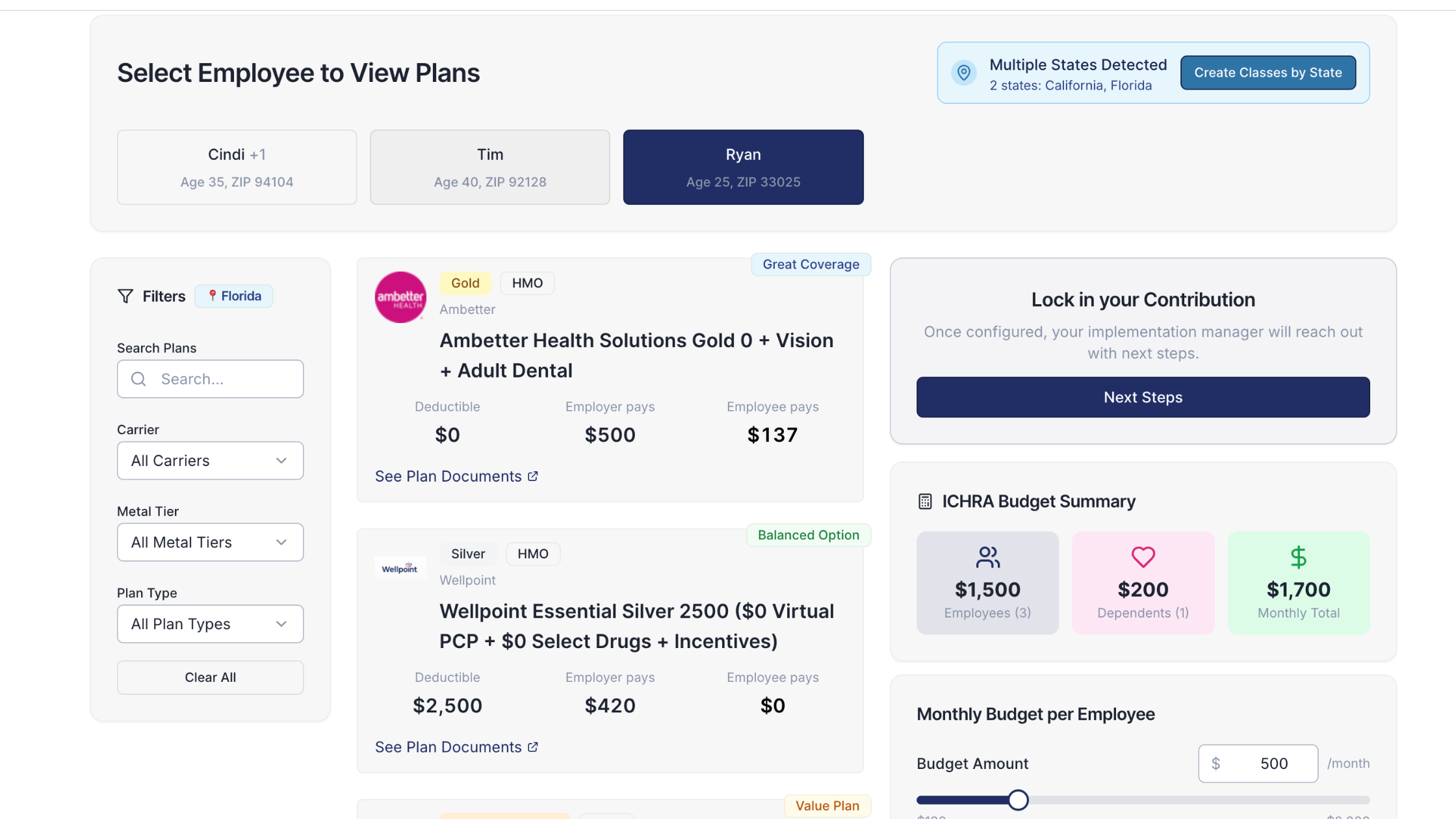How Much and Why Premiums Are Going Up For Small Businesses in 2026

For small business owners, managing expenses is a constant balancing act. After payroll, benefits are often the next largest line item, and navigating small business health insurance costs for 2026 is becoming a more significant challenge than ever. Projections show that companies are facing the sharpest premium increases in over a decade, a trend that is forcing many to re-evaluate their entire approach to employee health benefits.
While the numbers may seem daunting, this shift also presents an opportunity. It's a chance to move beyond traditional, one-size-fits-all plans and embrace more flexible, employee-focused solutions that can control costs and attract top talent. This article will break down how much premiums are expected to rise, the key reasons behind this surge, and how modern strategies like an Individual Coverage Health Reimbursement Arrangement (ICHRA) can offer a more sustainable path forward.
How Much Will Premiums Increase in 2026?
After a decade of relatively stable health benefit cost growth averaging around 3% annually, businesses are now bracing for a much steeper climb. According to a detailed analysis of rate filings from over 300 insurers, small businesses with Affordable Care Act (ACA)-compliant plans may see a median premium increase of 11% in 2026. In some states, the proposed median increase is even higher, at 12%.
Other industry analysts echo this sentiment, with projections for employer health insurance trends in 2026 ranging from a 6.5% to 10% hike, depending on the plan design. One major survey found that the average health benefit cost per employee is expected to rise by 6.5%, the highest increase since 2010. That figure is after accounting for cost-cutting measures; without any adjustments, costs could soar by nearly 9%.
This isn't just a minor adjustment; it's a significant financial pressure that will impact budgets and strategic planning for the year ahead. The premium changes can vary widely, with some insurers requesting increases of over 20%, highlighting the volatility in the market and the urgent need for a clear strategy.
The Key Drivers Behind Rising Health Insurance Costs
The health insurance premium increases for 2026 are not happening in a vacuum. They are the result of several interconnected economic and industry-specific factors. Understanding these drivers is the first step toward finding an effective solution for your business.
The Double Impact of Care Costs and Use
At its core, the primary reason for rising premiums is "medical trend," which simply means that the cost of healthcare services is going up, and people are using those services more frequently. Providers like hospitals and physician groups are facing their own economic pressures, including higher labor costs and general inflation, and they are passing those costs on through higher negotiated rates. At the same time, utilization is on the rise. Many people are now seeking care they may have delayed during the pandemic, and the growing acceptance of convenient telehealth options has made it easier for people to access services, further increasing demand.
The Surge in Prescription Drug Spending
A major contributor to rising health insurance costs is the escalating price of prescription drugs, particularly new specialty medications. Insurers consistently point to the high cost of GLP-1 drugs, a class of medications used for diabetes and weight management, as a significant factor driving up their projected expenses for 2026. The expense of these and other advanced therapies adds a substantial layer to the overall cost equation, forcing insurers to adjust premiums accordingly.
A Changing Risk Pool and Expiring Subsidies
A critical policy change is also influencing small business health insurance rates. Enhanced premium tax credits, which have made ACA marketplace plans more affordable for millions, are set to expire at the end of 2025. Insurers anticipate that without these subsidies, many healthier individuals will choose to drop their coverage. This would leave a sicker, more expensive group of people in the insurance pool, driving up average costs for everyone who remains. Some insurers estimate this factor alone could add an extra 4% to premium hikes.
The Outsized Impact on Small Businesses
While businesses of all sizes are feeling the pinch, small companies face a unique set of challenges. Health benefits are a powerful tool for attracting and retaining talent, and small businesses must compete with larger corporations that often have more resources to absorb rising costs.
For many small enterprises, simply shifting the increased small business healthcare expenses to employees through higher deductibles or paycheck deductions isn't a viable option. Doing so could make their benefits package less competitive, putting them at a disadvantage in a tight labor market. This pressure makes finding a cost-effective and attractive benefits solution not just a financial goal, but a strategic necessity.
A Modern Solution for Modern Workforce Needs
The current challenge with rising health insurance costs is also an invitation to innovate. Instead of trying to make old models fit new realities, businesses can turn to more flexible and predictable solutions. An Individual Coverage Health Reimbursement Arrangement (ICHRA) is a powerful alternative that puts employers in control of their budget while giving employees the freedom to choose a plan that truly fits their needs.
An ICHRA allows an employer to provide a tax-free monthly allowance that employees can use to purchase their own individual health insurance plan. This approach transforms benefits from a variable, unpredictable expense into a fixed, manageable one.
How Venteur Simplifies Your Switch to ICHRA
Making the move to an ICHRA can feel like a big step, but platforms like Venteur are designed to make the process seamless for employers, brokers, and employees alike. Here’s how Venteur provides a clear path forward:
- Empower Employees: Venteur offers a user-friendly marketplace where employees can shop for, compare, and select a health plan that works for them and their families. This aligns with Venteur’s "Your Health, On Your Terms" philosophy, giving workers the power of choice and the support of expert guidance to make informed decisions.
- Control Costs for Employers: With an ICHRA administered through Venteur, you set the budget. You decide the allowance amount, eliminating the risk of unexpected premium hikes. Companies can save up to 30% on healthcare costs, and Venteur’s transparent pricing—with no setup fees or monthly minimums—makes it an accessible option for businesses of any size.
- Expert Guidance and Support: Venteur ensures your ICHRA plan is fully compliant with all regulations and integrates smoothly with your existing payroll systems. For brokers and employers, Venteur provides hands-on support for every step, from initial setup to ongoing administration, ensuring a smooth and successful transition.
Preparing Your Business for 2026
With significant health insurance premium increases in 2026 on the horizon, proactive planning is essential. Instead of waiting for a renewal notice that could strain your budget, now is the time to take control.
- Review Your Current Plan: Analyze your current spending and understand how a potential double-digit increase would impact your company’s finances.
- Talk to Your Team: Benefits are for your employees. Engage them in a conversation to understand what they value most in a health plan—is it a low premium, a low deductible, or network flexibility?
- Consider New Models: Look into modern solutions like ICHRA. It’s a strategic move that can address the employer health insurance trends for 2026 head-on, providing budget certainty for you and valuable flexibility for your employees. By future-proofing your benefits strategy, you can turn a financial challenge into a competitive advantage.
You got questions, we got answers!
We're here to help you make informed decisions on health insurance for you and your family. Check out our FAQs or contact us if you have any additional questions.
This number varies widely based on factors like location, employee age, and plan design. However, a 2023 KFF survey found the average annual premium for employer-sponsored single coverage was $8,435, offering a general benchmark for costs.
- Consider high-deductible health plans (HDHPs) paired with Health Savings Accounts (HSAs).
- Look into alternative funding models like ICHRA to gain budget predictability.
- Work with a benefits broker to compare plans and find the most competitive rates.
- Implement wellness programs to encourage employee health, which may lower long-term claims.
An ICHRA (Individual Coverage Health Reimbursement Arrangement) is an employer-funded health benefit that allows companies to reimburse employees for individual health insurance premiums and other qualified medical expenses.
In most states, you can qualify for a small business group plan with as few as one or two employees, though the specific requirements can differ by state and insurer.
- Location: Rates differ significantly by state and even county.
- Employee Demographics: The average age of your workforce is a key factor.
- Plan Type: HMO, PPO, and high-deductible plans have different cost structures.
- Industry: Some industries are considered higher-risk, which can affect rates.
Explore more related content
What is Venteur
Explore the best human-first Health Insurance platform
Simple, personalized health benefits
Sign up in minutes, define your contribution, and let your employees choose the health plan that works right for them
Integrations to make everything run smoothly
We'll connect with your payroll and finance systems to make deductions and premium payments seamless
Easy onboarding and off-boarding
In just a few clicks, add your roster and make updates on the fly. We'll handle it from there.
Venteur Certified Brokers to help your employees pick the right plan
Our trusted brokers ensure the best outcomes for employees and employers by unlocking health savings and providing unrivaled plan options.
AI-powered plan recommendations to give you confidence while you shop
Backed by 30 years of healthcare data, Venteur’s AI helps employees compare and choose the best plan for their unique situation.
Compliance and reporting because no-duh!
Venteur manages plan administration, reporting, and compliance so you can focus on growing your business.


